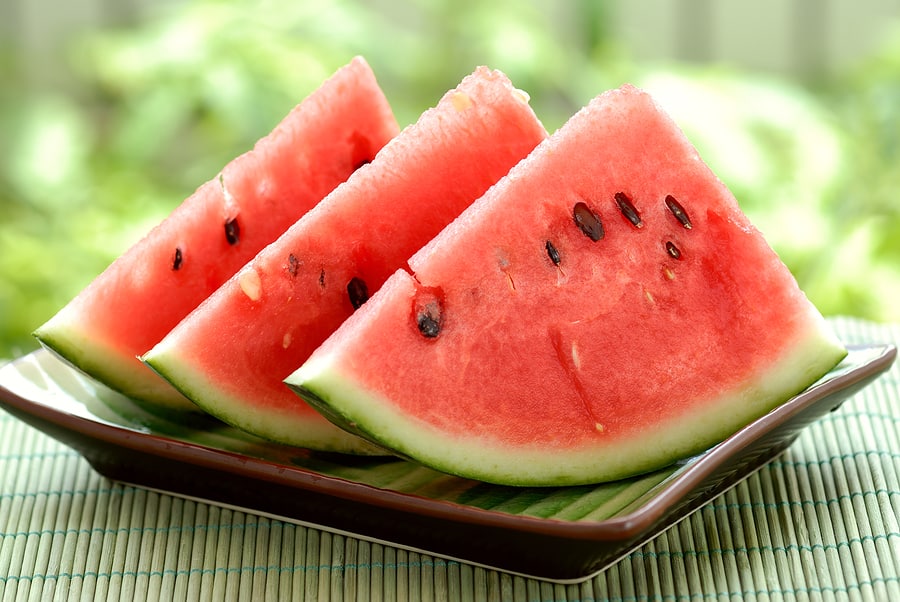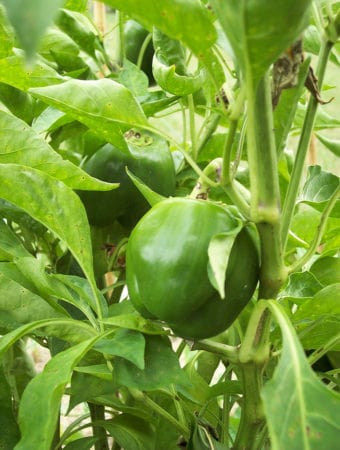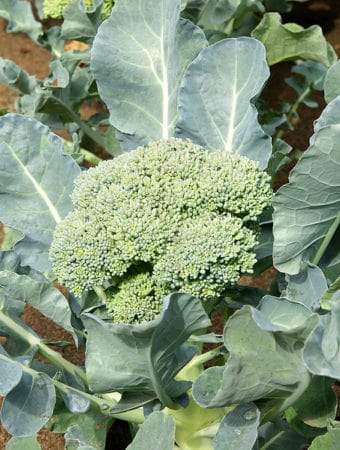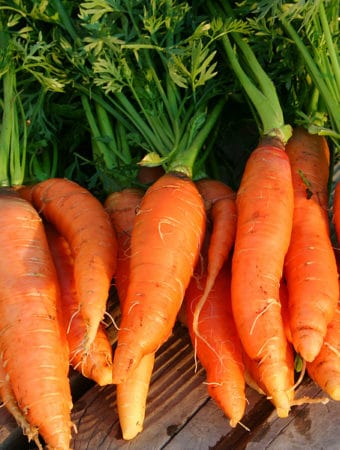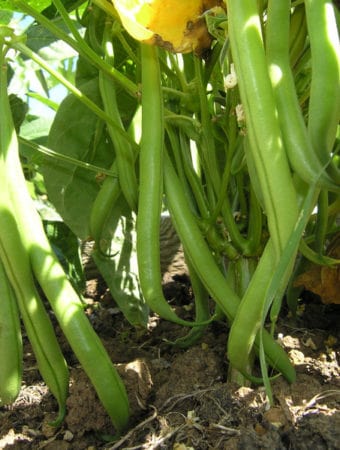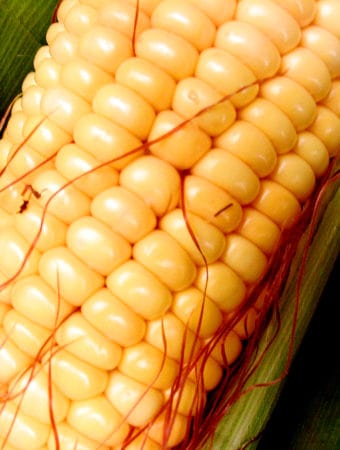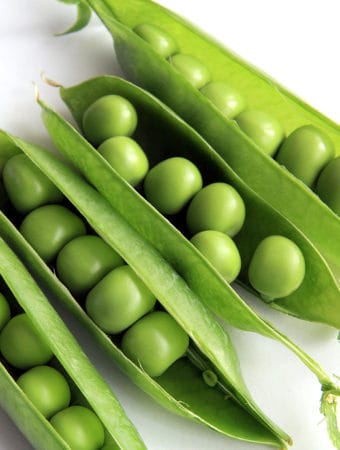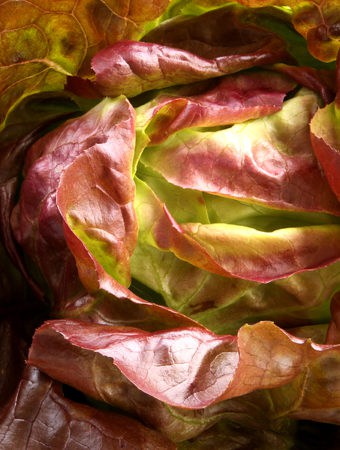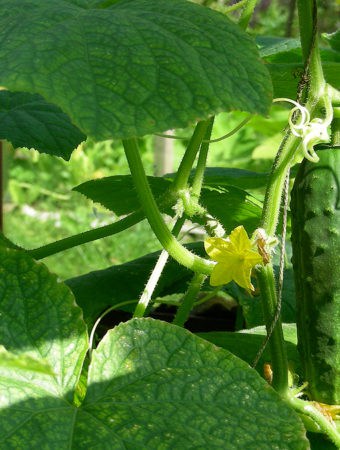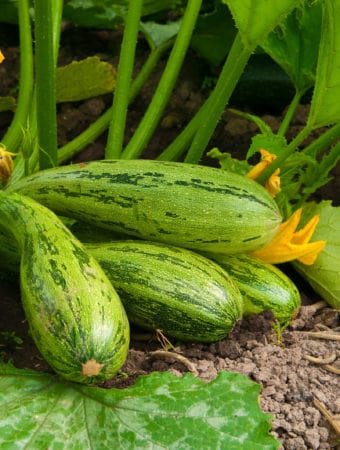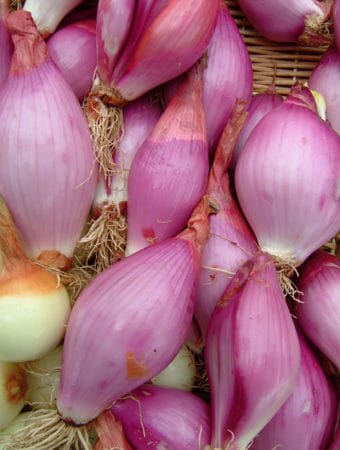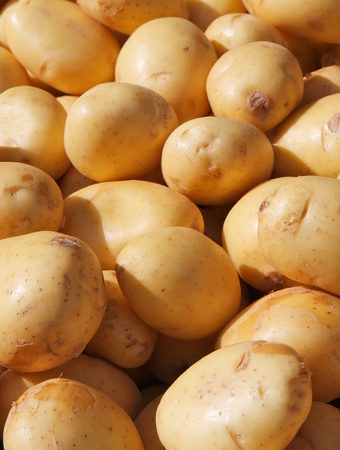The watermelon is a tender, warm-weather annual. Watermelons along with muskmelons and cantaloupes are sometimes called summer melons. They thrive in hot weather.
Watermelons are easy to grow. They need plenty of sun, nutrient-rich soil, and plenty of water. Get watermelon started in the home garden after all danger of frost has passed and your harvest of sweet, juicy watermelon will come in late summer.
Watermelons need warmth, water, sun, and space. But if you are short on warmth–you live in a short-summer region–or space, not much yard, you can still grow delicious, sweet watermelons in a home garden.
Related article:
Here is your complete guide to growing watermelon.
Watermelon growing quick tips
- Sow watermelon seeds in the garden or set out transplants 3 to 4 weeks after the last average frost date in spring.
- Start watermelon seeds indoors 4 to 6 weeks before transplanting seedlings into the garden. Start seed indoors in 4-inch or larger biodegradable peat or paper pots that can be set wholly into the garden so as not to disturb the roots.
- Harvest will come 65 to 90 frost-free after seed sowing depending on the variety of watermelon you are growing.
Related articles:
- Serve Watermelon With These Flavor Matches
- Tasty Ways to Serve Melons
- Watermelon Seed Starting Tips
- How to Harvest and Store Watermelon
- Melons Seed Starting Tips
- How to Plant and Grow Melons
- How to Plant and Grow Watermelon
- How to Harvest and Store Melons
- Melons Growing Problems Troubleshooting
- How to Plant and Grow Watermelon
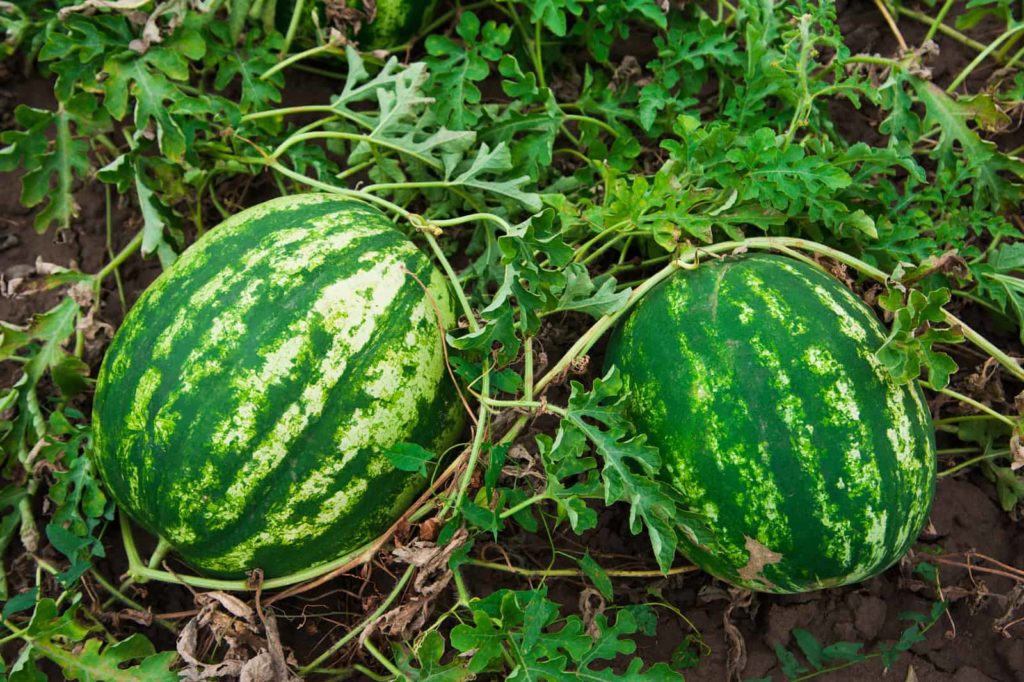
Watermelon growing requirements
Large watermelons require 4 months of frost-free, very warm weather to come to harvest, and they can gobble up as much as 144 square feet (13 sq. meters) of space. But if you have less than 90 growing days, you can still harvest a watermelon. (See the short-season list below.) And if you have as little as 12 to 16 square feet–that’s 4 feet by 4 feet (1.2m x 1.2m), you still have enough space to grow watermelon. (See the short vine or bush variety list below.)
Watermelon and temperature
Watermelon demands warm temperatures—both soil and air. Transplant or direct seed watermelon only when the average soil and daytime air temperatures are at least 70°F (21°C). Do not grow watermelon unprotected where nighttime air temperatures fall below 60°F (16°C). If the air temperature dips, protect watermelons with floating row covers.
Good Products for Pest and Disease Control at Amazon:
- Garden Safe Snail and Slug Bait
- Bonide Sulfur Fungicide
- Monterey BT Caterpillar Killer
- Neem Bliss 100-% Cold Pressed Neem Oil
- Safer Brand Insect Killing Soap
- PyGanic Botanical Insecticide
Where to plant watermelons
Grow watermelon in rich, well-drained soil. Planting watermelons on hills or mounds ensures that roots stay warm and that the soil is well drained. Amend the planting area with compost and well-rotted manure. Where you plan to sow seed or set transplants, dig a hole 1 foot (30 cm) deep and 1 foot wide; fill the hole with rich aged compost and manure mixed with several handfuls of sand—the growing spot will be both moisture retentive and well-draining. Add a handful each of rock phosphate (rich in phosphorus), earthworm castings (all-around nutrient-rich), and Epsom salts (rich in magnesium). Use the soil removed from the hole to build a mound on top and rake it flat. Sow seed or set a transplant there. Watermelon roots commonly grow 8 to 10 or more inches deep; the hole and mound become a reservoir of moisture and nutrients.
- Plant watermelons in full sun.
- Watermelons grow best in loose, well-drained, but moisture-retentive soil rich in organic matter.
- Add aged compost and aged manure or a commercial organic planting mix to the planting bed before planting. Turn the soil to 12 inches (30cm) deep.
- Watermelons prefer a soil pH of 6.0 to 6.8. A soil test will tell you if you need to amend the soil.
- Plant watermelons on hills or mounds or on raised rows. Solar heat hitting the soil on a mound or raised row will keep plants and roots warm.
- Create a mound 6 to 12 inches (15-30cm) high and 5 feet (1.5m) across.
- If planting in ground-level beds, warm the soil in advance of planting by laying black plastic sheeting on the bed two weeks before planting.
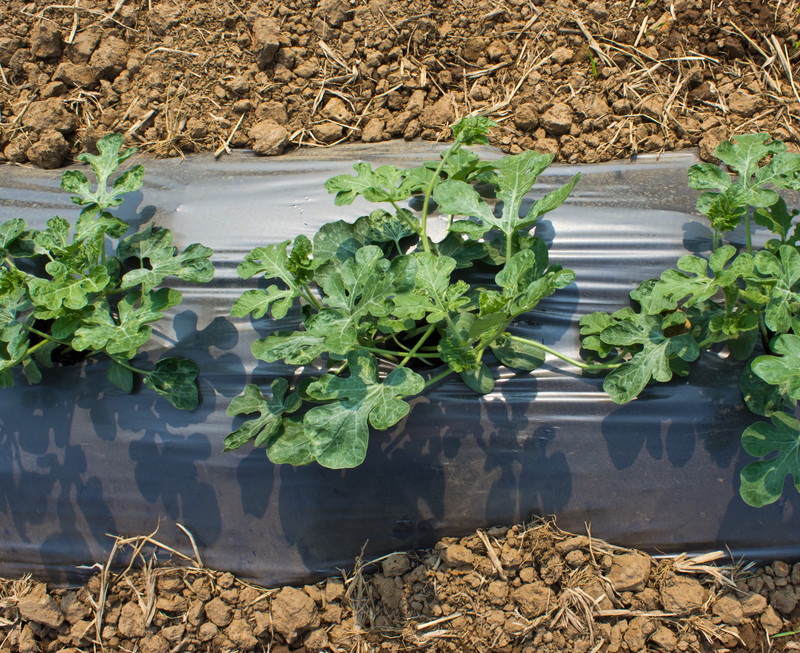
Watermelon planting time
- Sow watermelon seed in the garden or set out transplants 2 to 3 weeks after the last average frost date in spring when all danger of frost has passed.
- Garden soil temperature should be at least 70°F (21°C) at planting time. Pre-warm the soil by placing black plastic sheeting over the planting bed for two weeks prior to planting.
- To get a head start on the season and in short growing season regions, start watermelon seed indoors about 4 to 6 weeks before transplanting seedlings into the garden; start seed in biodegradable peat or paper pots at least 4 inches (10cm) in diameter that can be set wholly into the garden so as not to disturb roots.
- Watermelon seed will germinate in about 10 days at 65°F (18°C), sooner in warmer soil. Seedless watermelon varieties are best germinated at about 85°F.
- The average room temperature is just about right for germinating watermelon seeds indoors.
- Watermelons grow best in warm temperatures ranging from 70° to 90°F (21-32°C).
- Avoid growing watermelon where night temperatures dip below 50°F (10°C); this will cause the fruit to lose flavor.
- If temperatures exceed 90°F (32°C).
- for several days, flowers will drop without setting fruit.
- Watermelons require 65 to 90 frost-free days to reach harvest depending on the variety.
- Watermelons will tolerate no frost. In cool or short-season regions, grow smaller varieties that come to harvest quickly.
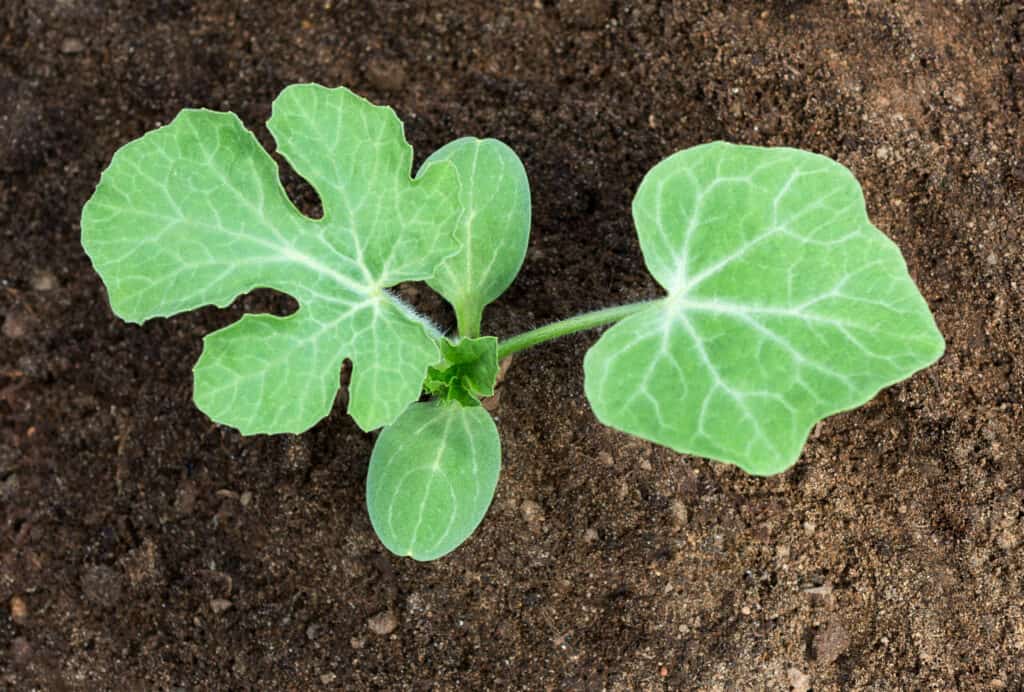
Planting and spacing watermelons
Plant watermelons in light loam to sandy-loam soil; avoid planting in heavy or clay soil. Plant when the soil temperature has warmed to at least 70°F. (You can get a head start in cool regions by sowing watermelons indoors 6 weeks before planting out.)
Center your vine in the space you have, and dig a hole 3 feet (.9m) in diameter and 12 to 18 inches (30-45cm) deep, a bit deeper in the center. Add rich compost or planting mix to the hole and tamp it down; watermelons require consistent even watering, and this compost-rich planting bed will serve as a moisture reservoir. Mound the soil above the re-filled bed to 6 inches (15cm) tall. Plant 5 to 6 seeds or set two starts on this mound. Thin to the strongest plant. Space mounds 12 feet (3.6m) apart unless you are planting the short vine, bush varieties listed below–then you can plant a third to half that distance.
Space watermelons 6 to 12 feet (1.8-3.6 m) apart; don’t let plants compete for soil moisture or nutrients. (Keep weeds down until vines spread and shade the soil.) If watermelons are stressed for water or nutrients when they start to set fruit, they will be small and less flavorful.
- Sow watermelon seed 1 inch (2.5cm) deep.
- Sow 4 to 6 melon seeds on a mound or hill.
- Germination will occur in about 10 days when the soil is 70°F (21°C).
- Thin watermelon seedlings to 2 or 3 strong seedlings on each hill when seedlings have developed three or four true leaves. Cut the thinned seedlings at the soil level with scissors so as not to disturb the roots of the remaining seedlings.
- Space mounds or hills 5 to 6 feet (1.5-1.8m) apart.
- Mounds can range in height from a few inches to more than 12 inches (30cm) tall; mounds will allow vines to run away down the slope. You can train vines to circle the mound.
- If you are growing watermelon in rows space plants 4 to 5 feet apart (1.2-1.5m) and space rows 6 feet (1.8m) apart.
- Grow 2 watermelon plants for each household member.
More tips: Watermelon Seed Starting Tips.
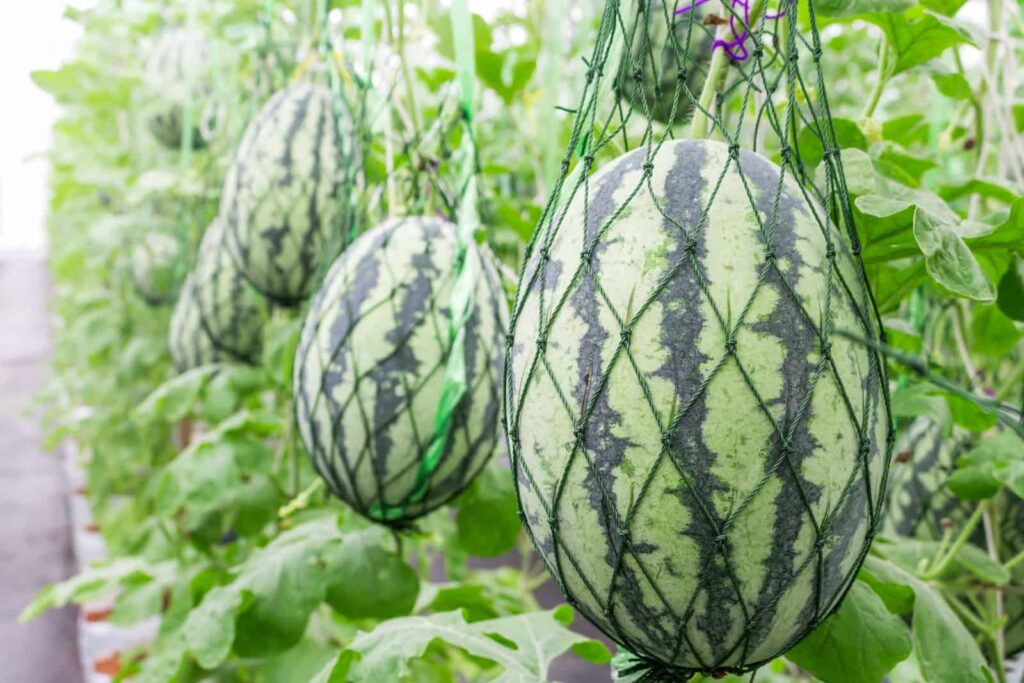
Mulching watermelons
Once watermelon fruits begin to develop, place a board, a piece of tile or plastic, or thick straw mulch under each fruit. This will reduce contact with the soil and lessen insect damage or rotten spots on the bottom of the fruit. A board, tile, or piece of plastic will soak up solar heat and transfer it to the melon.
Growing watermelons vertically
- Watermelons can be grown on a trellis.
- Use a trellis at least 8 x 8 feet (2.4m) wide or wider. Make sure the trellis is well-anchored.
- Space plant at the base of the trellis 3 to 4 feet (.9-1.2m) apart.
- Train vines up the trellis; secure the vines to the trellis with elastic garden tape.
- Support melons growing on a trellis with netting. Nylon netting will easily support a whole watermelon if tied into well-anchored support.
- You can also grow watermelons on an A-frame trellis. Lean two trellises together, tie them at the top, and anchor the base of each trellis.
Container growing watermelons
- Watermelons are usually too large to grow in a container.
- Select a bush, dwarf- or mini-cultivar to grow in a container.
- Chose a container that is at least 18 inches wide and deep to grow one watermelon.
- Grow watermelons in compost-rich potting soil; check at the garden center for recommended commercial mixes best suited for melons.
- In the short growing season regions extend the season by starting melons in containers indoors; move them outdoors when the weather has warmed but be careful not to pinch or break the vines.
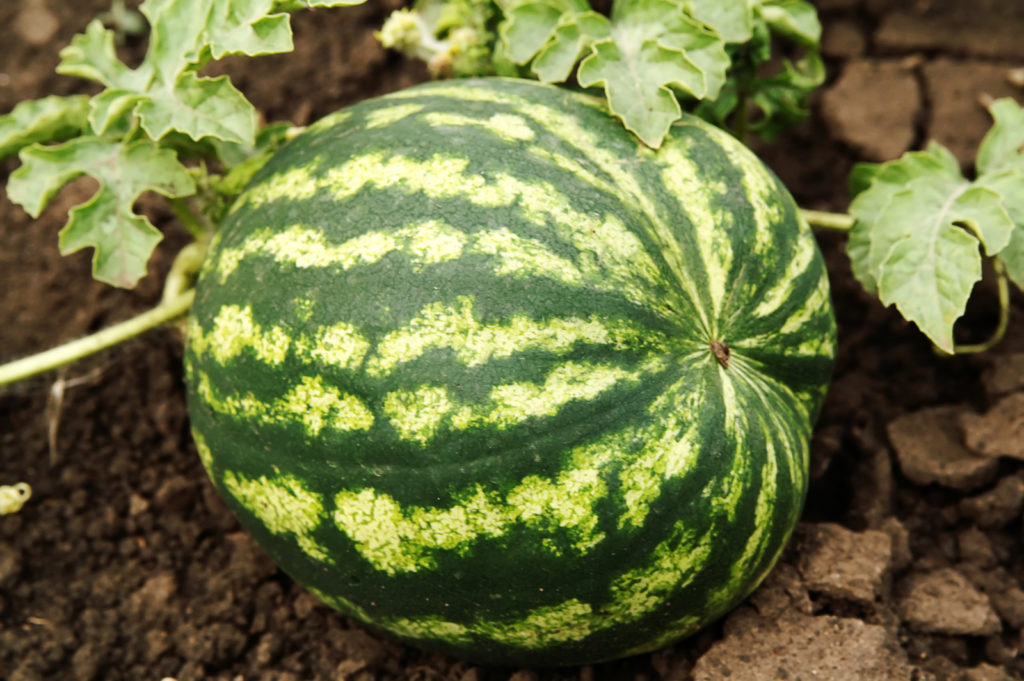
Watering watermelons
Your yield will be small if you don’t keep watermelons irrigated. If you depend upon rain and rain is in short supply, get as early a start as possible. Watermelon roots will do their part to find moisture; they will grow to 6 feet (1.8m) deep. Irrigation will increase yields.
Water. Give watermelons even moisture from planting through fruit set. During the first 3 to 4 weeks of growth a watermelon develops its root system. The root system supplies the growing plant with both moisture and nutrients. An extensive and strong root system allows the watermelon to take up nearly 95 percent of its weight in water and develop its large cells which are easily seen with the naked eye—these large, water-filled cells give watermelon its crunchy, crisp, yet tender consistency. Never allow a developing watermelon to dry out completely or it may split. Water whenever the top 3 to 4 inches (8-10 cm) of soil become dry; simply stick your finger into the soil to test the soil moisture. Apply a heavy mulch to keep the soil moist after the sun begins to warm the garden in summer.
When to water. Do not overwater a watermelon once it has begun to set fruit or its developing natural sugars will be diluted. The leaves of a watermelon commonly wilt in the hot afternoon sun. Water immediately if the watermelon’s leaves wilt before noon or if they appeared stressed by heat or drought. Never allow the vine itself to become dry. A soaker hose or drip irrigation is the best way to deliver water to watermelon roots; overhead watering may encourage the development of fungal diseases which commonly attack leaves.
No water. Stop watering a watermelon about 2 weeks before the fruits are ready to harvest. Holding back water at this point will concentrate the plant’s sugars and the fruits will become sweeter tasting. More tips:
- Watermelons are 95 percent water. They require plentiful regular, and even watering for quick growth.
- Give watermelons 1 to 2 inches (2.5.-5cm) of water every week (1 inch equals 16 gallons/60.5 liters.)
- Keep the soil moist until the fruit reaches full size then stop watering while the fruit ripens.
- Mulch to retain soil moisture. Spread straw or dried chopped leaves around watermelon plants after the soil has warmed. You can also lay black plastic sheeting or garden fabric across the planting bed. Cut an x-slot in the fabric to plant.
- Water at the base of plants with a soaker hose or drip irrigation. Wetting the foliage will leave plants susceptible to fungal diseases such as powdery or downy mildew.
- Keep the soil evenly moist during flowering and fruit development. A week or so before harvest cut back on water; dry soil will help plants concentrate sugars in the fruit.
- If leaves are wilted in the morning, the plants need water. Wilting leaves at the end of the day is not uncommon.
Feeding watermelons
Feed watermelons with a dilute solution of fish emulsion fertilizer—1 tablespoon per gallon of water—weekly from the time the plant is seedling until the first female flower appears. (Mark the calendar on the day the female flowers fully open—the fruit will be ready for harvest 35 days later.)
- Prepare planting beds with aged compost and aged manure or a commercial organic planting mix. Turn the soil to 12 inches (30cm) deep.
- Watermelons are heavy feeders. Add several inches of aged manure across planting beds in the autumn before planting.
- Side dress watermelons with compost or manure tea or a dilute solution of fish emulsion every 2 to 3 weeks during the growing season.
- Watermelons can be side dressed with an even organic fertilizer such as 10-10-10 early in the season but once flowers and fruit appear, reduce nitrogen and increase phosphorus and potassium; use a 5-10-10 fertilizer.
Watermelon companion plants
- Plant watermelons with corn, radish, beans, and nasturtiums.
Watermelon pollination
Watermelon plants have separate male and female flowers so bees are required for pollination. Thin each planting mound to no more than two melons for best results.
- Watermelon plants produce both male and female flowers.
- Male flowers appear a week or two in advance of the female flowers. Male flowers attract bees that are needed for pollination once female flowers appear.
- Female flowers will have a small bulge at the stem end of the flower. This bulge is an embryonic fruit.
- Some male flowers will die and drop before female flowers set fruit.
- You can hand-pollinate watermelon flowers using an artist’s bristle brush. Rub the brush in the male flower to collect pollen then rub the brush in the center of the female flower to transfer the pollen.
- You can attract bees to your garden by planting flowering herbs such as dill, borage, and lavender nearby.
Growing seedless watermelon
- Seedless watermelons are not truly seedless, though they look seedless. They contain nearly transparent seeds.
- Seedless watermelons are known as triploid watermelons. They are a cross between a common diploid melon and a tetraploid melon. The female flowers on a seedless plant must be pollinated by male flowers from a seeded variety. This process can be complicated for a home gardener.
- Home gardeners can purchase seedless watermelon seed packets that will include the seed of a pollinator cultivar to be planted nearby.
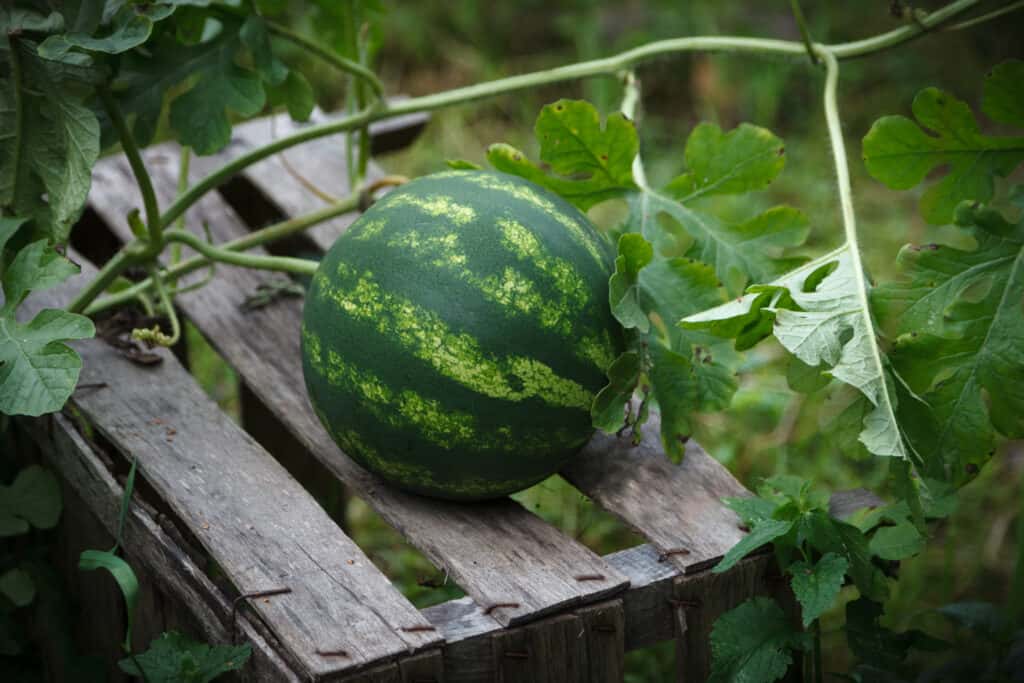
Caring for watermelons
- Early in the season cover plants with a floating row cover. This will keep insects away and hold warm air around plants. Once plants begin to flower, remove the row cover during the day so that bees can get to the flowers.
- Encourage watermelon plants to set three or four fruits at the same time; if a plant sets one fruit early, pinch it out to encourage the plant to develop several fruits at the same time. One fruit off to a head start can suppress all further fruiting on the vine until that fruit matures.
- Cultivate carefully around vines until they cover the ground and smother out competing weeds.
- Mulch around watermelons with straw, dry chopped leaves or set down black plastic mulch (sheeting) or garden fabric. Mulch will keep down weeds and conserve soil moisture.
- For sprawling watermelons, place a tile, wooden shingle, or a piece of plastic under each melon to keep the fruit clean and dry and to store solar heat which will help ripen fruit.
- About 50 days before the first expected autumn frost, remove all new blossoms from a plant; this will allow the plant to concentrate its energy on the development and ripening of fruit already on the plant.
Watermelon pests
- Aphids and spotted and striped cucumber beetles will attack melons.
- Hose away aphids with a blast of water or pinch out infested foliage.
- Hand-pick and destroy cucumber beetles promptly; they can transmit cucumber bacterial wilt to melons. You can also control cucumber beetles by spraying insecticidal soap, neem oil, or dusting with kaolin.
- Organic pesticides such as horticultural oil or neem oil are best suited for controlling insect pests.
More tips: Melon Growing Problems: Troubleshooting.
Watermelon diseases
- Watermelons are susceptible to anthracnose, Alternaria leaf spot, bacterial wilt, and powdery and downy mildew.
- Planting disease-resistant varieties when they are available and maintaining the general cleanliness and health of your garden will help cut down the incidence of disease.
- Do not handle the vines when they are wet; this can spread fungal diseases.
- If a plant does become infected remove it before it can spread the disease to healthy plants.
- Anthracnose is a soil-borne fungal disease that can cause leaf spots, leaf drop, wilting, and sometimes death. Keep the garden clean and plant disease-resistant varieties. Remove diseased plants from the garden immediately.
- Bacterial wilt which is spread by cucumber beetles can cause watermelon plants to suddenly wilt and die just as they begin to produce fruit. Control cucumber beetles as soon as they appear.
- Fusarium wilt is a fungal disease that causes leaves to curl and drop and stems to curl. Add lime to the soil ahead of planting; avoid overwatering during the season.
- Gummy stem blight is a fungal disease that causes leaves to yellow and die. This disease is hard to control; pull up plants and dispose of them in the trash. Rotate crops each year.
- Powdery mildew and other fungal diseases can be prevented and slowed by spray-misting plants with compost tea or a solution of 1-part skim milk and 9-parts water.
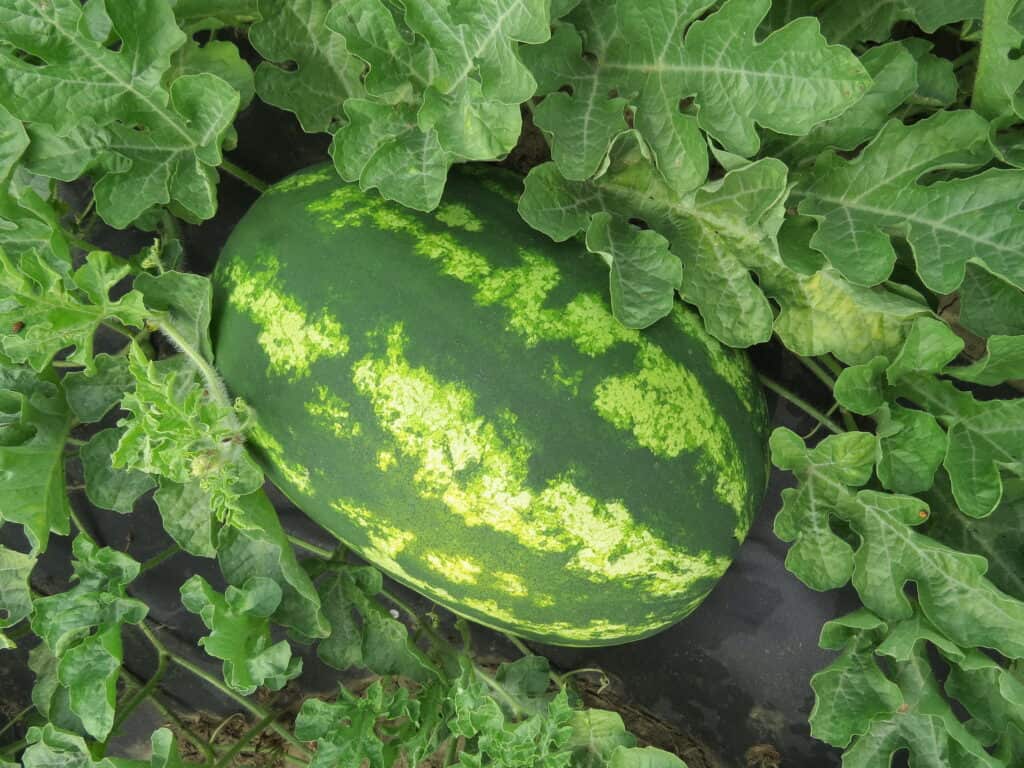
Harvesting watermelons
A watermelon is ready for harvest when the curly tendrils on the stem nearest the fruit dry up and turn brown and the spot on the bottom of the fruit turns from white or green to yellow or creamy yellow and the top of the fruit turns a dull color. Mark Twain observed that a green melon says “pink” or “pank” when thumped with the knuckles. A ripe watermelon says “punk.” “Punk” is best described as a solid dull sound
- Watermelons will be ready for harvest 65 to 90 days after sowing depending on the variety.
- When watermelons are ready to harvest vine tendrils will begin to turn brown and die off. If the tendrils are green the melon is not ripe.
- You can also test for watermelon ripeness by rapping your knuckle against the melon; a ripe watermelon will make a dull hollow sound when thumped.
- The soil side of a watermelon will turn from white to pale yellow when the fruit is ready for harvest.
- Ripe fruit will have a sweet aroma at the stem end.
- Limit water for a week in advance of the harvest to concentrate sweetness.
- Watermelons on a single plant will all be ready for harvest over a two-week period.
- Use a sharp knife or garden pruner to cut the watermelon away from the vine.
- Watermelons do not continue to ripen off the vine.
Storing and preserving watermelons
- Watermelons will keep in the refrigerator for up to a week if not cut or sliced, but sweetness and flavor may diminish.
- A cut watermelon will keep in the refrigerator for about 4 days. Wrap the melon tightly in plastic to prevent cold burn or dehydration.
- It takes about 12 hours to chill a large watermelon.
- Watermelons can be kept in a cool, moderately moist place for 2 to 3 weeks without refrigeration.
- Melon flesh can be frozen and rinds can be pickled.
More tips: How to Harvest and Store Watermelon.
Watermelon frequently asked questions
Q: Should I start watermelons indoors?
A: To ensure watermelons have enough warm and hot weather to ripen, start seeds indoors 3 to 4 weeks before the average date of the last frost. Plant seeds n peat pots or other biodegradable containers that can be set directly in the ground; watermelons don’t like their roots to be disturbed at transplanting time.
Q: When can watermelons be planted outdoors?
A: You can transplant watermelons into the garden when temperatures average 60°F, even warmer is better. Protect young seedlings with hot caps or cloches. Plastic milk jugs with their bottoms cut out will work, but remember to remove them during the day if the sun is bright.
Q: What’s the best way to plant watermelon seeds?
A: Sow seeds 1 inch deep in hills, two to four seeds per hill, 4 to 6 feet apart. Some bush varieties can be spaced closer together.
Q: Can watermelons be grown on a trellis?
A: Yes. To be certain the fruits don’t break off, or pull the vines away from their support, create a little “hammock” for them with nylon netting or pieces of cloth.
Q: Can I grow watermelons in very dry regions?
A: Yes, try this: create a depression 3 to 5 inches deep and 12 to 15 inches across. Sow seeds or set transplant halfway up the sides of the depression then train the vines away from the depression. Water in the depression and the water will wick up to the roots, and the vine trained away will not get muddy.
Q: Can I grow watermelons in cool summer regions?
A: In cooler climates, grow smaller “ice-box: varieties. Plant these smaller melons in the warmest spot in your garden. Use black plastic mulch to trap heat in the soil.
Q: How much fertilizer do watermelons need?
A: Give watermelons a complete organic fertilizer at planting ot transplanting time and again when plants are established and just starting to send out runners. Work the fertilizer into the soil in circular furrows 8 inches away from the plants.
Q: Will watermelons need extra water?
A: Watermelons need plenty of water, but they also must have good drainage. Keep the soil evenly moist. Planting on mounds will ensure good drainage.
Q: How can I tell when a watermelon is ready to harvest?
A: Rap the melon with your knuckle. If the sound is sharp and high, the melon is not ripe. If the sound is dull and hollow, the melon is ripe. When the tendril closest to the melon is alive and green, it is not ripe. When the tendril dries up and turns brown, the melon is ripe. You can also look for yellowing on the spot where the melon rests on the ground.
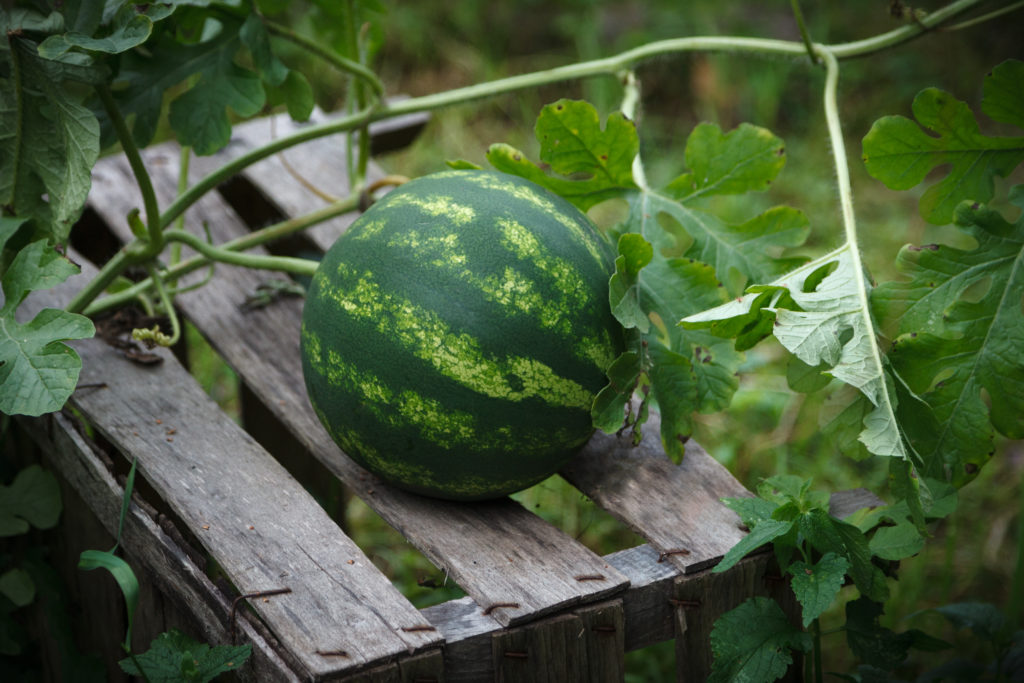
Watermelon recommended varieties
Bush or short vine watermelons–for small spaces:
- Bush Charleston Gray. (F) 90 days. High sugar content. Small, oblong fruit similar to Charleston Gray except for the smaller size of fruit and vine; weighs 10 to 13 pounds. Gray-green rind; flesh deep red, fine-textured. Needs just 3 to 5 feet across. Ideal for small gardens. Open-pollinated.
- Bush Jubilee. (AN, F) 90-100 days. Sweet, high sugar content. Small, oblong fruit to 24 inches long; weighs 25 to 35 pounds. Light green rind with dark green stripes; bright red flesh, firm texture. Spreads just 3 to 5 feet. Open-pollinated.
- Bush Sugar Baby. 75-80 days. Juicy, sweet flesh. Small, round fruit; weighs 12 pounds; dark green rind with no stripes; red flesh. Vine spreads just 3 to 3½ feet. Open-pollinated.
Long vine watermelons–for large spaces:
- Calsweet. (F). 90-92 days. Sweet. Large, oblong fruit to about 17 inches; weighs 25 to 30 pounds. Rind light green with dark green stripes; bright red flesh. Open-pollinated.
- Charleston Gray. (AN, F). 85-100 days. Excellent, crisp flavor. Large, cylindrical fruit to 24 inches long; weighs 30 to 35 pounds. The thin but tough rind is light greenish-gray; red flesh. Vigorous vine. Sunburn and heat resistant. Open-pollinated.
- Crimson Sweet. (AAS, AN, F). 80-97 days. Very sweet, high sugar content. Large, slightly elongated fruit to12 inches long; weighs 35 to 30 pounds. Thick, hard rind; light green darker green stripes; bright red flesh, fine texture. Open-pollinated.
- King of Hearts. 80-85 days. Sweet, delicious, crisp. Oval-shaped; thick green rind with medium green stripes. Bright red flesh, medium texture. Hybrid.
- Sugar Baby. 68-86 days. Big melon sweetness. Small, round fruit fits in the icebox, 6 to 8 inches long; weighs 8 to 10 pounds. Thick, dark green rind turns almost black; bright red-orange flesh, fine texture. Excellent for a home garden. Open-pollinated.
Short-season watermelons–less than 90 days:
- Cole’s Early. 80 days. Sweet, good quality. Broad, oval fruit; weights15-20 pounds. Thin rind; dark green with light green stripes; light red flesh. Popular in northern states. Open-pollinated.
- Sugar Baby. See above.
- Fordhook Hybrid. 75 days. Juicy, delicious. Weighs 14 pounds. Red flesh. Vigorous grower.
- Yellow-flesh fruit.
- Yellow Baby. (AAS) 75 days. Sweet, excellent flavor. Small, round to oval fruit to 7 inches in diameter; weighs 8 to 10 pounds. Thin rind; light green with darker green stripes; bright yellow flesh. Good storage. Hybrid.
- Yellow Doll. 65-70 days. Extra sweet, crisp. Small, round to oval fruit; weighs 4 to 8 pounds. Thin rind; green with dark green stripes; yellow flesh. Semi-compact vine. Open-pollinated.
Abbreviations:
AAS: All-America Selection (resists most diseases)
AN: Anthracnose resistant
F: Fusarium diseases resistant
Watermelon varieties by size
- Icebox size watermelons: ‘Early Midget’ (65 days); ‘Garden Baby’ (70 days); ‘Golden Midget’ (65 days); ‘Sugar Baby’ (68-96 days); ‘Tiger Baby’ (80 days).
- Oblong, green rind: ‘Northern Sweet’ (68 days).
- Oblong, grayish rind: ‘Allsweet’ (100 days); ‘Calsweet’ (92 days); ‘Charleston Gray’ (90 days); ‘Desert Storm’ (80 days); ‘Fiesta’ (85 days); ‘Regency’ (82 days); ‘Royal Majesty’ (80 days); ‘Sangria’ (85 days); ‘Strawberry’ (85 days); ‘Sun Sweet’ (85 days); ‘Sweet Favorite’ (64-79 days).
- Round, green: ‘Black Diamond’ (75-95 days); ‘Black Diamond Yellow Belly’ (90 days); ‘King and Queen’ (80-90 days); ‘Moon and Stars’ (100 days).
- Round, striped: ‘Crimson Sweet’ (80-96 days); ‘Navajo Sweet’ (90 days); ‘Super Sweet’ (90 days).
- Giant-sized: ‘Carolina Cross’ (100 days).
- Space savers: ‘Bush Sugar Baby’ (80 days); ‘Garden Baby’ (75 days); ‘Petite Sweet’ (75 days); ‘New Hampshire Midget’ (77 days); ‘Sugar Baby’ (79 days).
- Yellow or orange flesh: ‘Arikara’ (85 days); ‘Yellow Doll’ (75 days).
More varieties to grow: Watermelons for Home Gardens: Top 12 Varieties.
About watermelons
- The watermelon is a long-trailing annual plant.
- Watermelons can be solid green or striped green and white.
- Watermelons can be oval, oblong, or round.
- Fruits can weigh from 10 or 15 pounds to more than 100 pounds. Fruits are commonly 30 pounds or more.
- The watermelon has a thick, solid rind with sweet, succulent flesh that can be pink, red, yellow, orange, or grayish-white.
- Male and female flowers appear on the same vine.
- Botanical name: Citrullus vulgaris
- Origin: Tropical Africa
Melon articles at Harvest to Table:
How to Plant and Grow Watermelon
How to Harvest and Store Melons
How to Harvest and Store Watermelon
Melons Growing Problems Troubleshooting
Serve Watermelon With These Flavor Matches
More how to grow articles:
Learn how to plant, grow, and harvest your favorite vegetables. Click below for all you need to know.
- Artichoke
- Arugula
- Asparagus
- Beans, Snap
- Beets
- Broad Beans
- Broccoli
- Brussels Sprouts
- Cabbage
- Cantaloupe — Melons
- Cardoon
- Carrots
- Cauliflower
- Celeriac
- Celery
- Chard
- Chayote Squash
- Chickpeas
- Chicory
- Chinese Cabbage
- Collards
- Corn Salad
- Corn, Sweet
- Cresses
- Cucumbers
- Eggplant
- Endive and Escarole
- Fava Beans
- Florence Fennel
- Garbanzo Beans
- Garlic
- Horseradish
- Jerusalem Artichoke
- Kale
- Kohlrabi
- Leeks
- Lettuce
- Lima Beans
- Melons
- Mizuna
- Mustard Greens
- New Zealand Spinach
- Okra
- Onions
- Parsnips
- Peanuts
- Peas
- Peppers
- Potatoes
- Pumpkins
- Radicchio
- Radishes
- Rhubarb
- Rutabaga
- Salsify
- Shallots
- Sorrel
- Southern Peas
- Soybeans
- Spinach
- Squash, Summer
- Squash, Winter
- Sunchokes
- Sweet Potato
- Swiss Chard
- Taro
- Tomatillo
- Tomatoes
- Turnips
- Watermelon
- Zucchini
Related articles:
How to Harvest and Store Watermelon
How to Serve Summer and Winter Melons
Garden Planning Books at Amazon:
- Vegetable Garden Almanac & Planner
- Kitchen Garden Grower’s Guide Vegetable Encyclopedia
- Vegetable Garden Grower’s Guide
- Tomato Grower’s Answer Book


